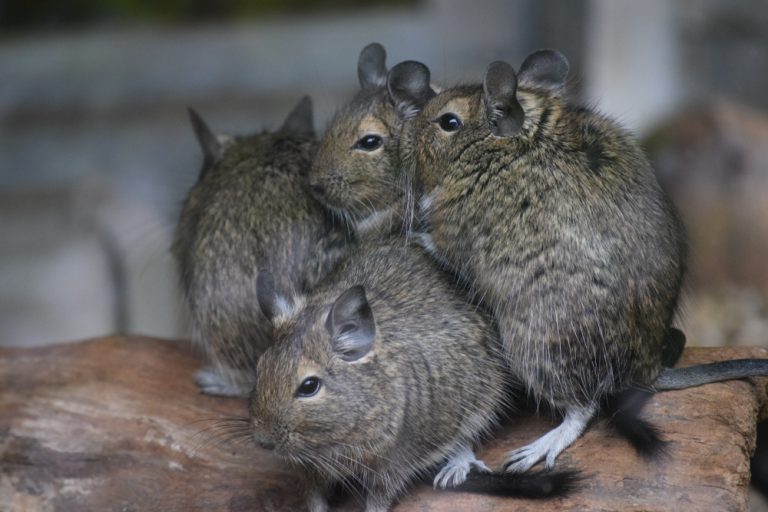Can Chinchillas Live Alone?
When you’re buying a pet, you’ll often start with only one. But not all pets are used to living alone. There are a lot of pocket pets that are social animals that live in groups in the wild. So if you’re looking to buy a chinchilla, it’s vital to know if a chinchilla can be kept alone.
Can chinchillas live alone? Chinchillas are animals that live in colonies in the wild. In general, it’s not wise to keep a single chinchilla, and it’s highly advised to keep at least a pair of chinchillas. There are some cases where a chinchilla is kept as a solitary pet. In that case, you’ll need to shower your chinchilla with a lot of attention.
Chinchillas are group animals that love to spend time with other chinchillas. They’re not used to living alone like some pocket pets. It is possible to keep a chinchilla alone, but I wouldn’t recommend it. You’ll need to give them a lot of attention. If you want to add another chinchilla, you might experience difficulties because the chinchillas are not used to each other.
In this article, you’ll learn why it’s best to keep at least a pair of chinchillas, how to keep them from fighting and what to do if you want to house only a single chinchilla in your home.
This site contains affiliate links to products we recommend and use ourselves. We may receive a commission for purchases that you make through these links. If you’re interested in learning more about our affiliate links, please visit our (affiliate) disclaimer.
Social Structure in the Wild
Wild chinchillas live in colonies that can have up to several hundred members. Chinchillas are matriarchal, and the females are often aggressive toward each other. They are also aggressive toward male chinchillas during mating season. Chinchillas, however, rarely fight each other. They generally settle their disputes through threat displays that can include growling, urinating, and chattering their teeth.
Wild chinchillas mate during the winter. The females typically remain with a single mate, and they produce two litters every year. Each litter will usually include two or three babies, and the gestation lasts four months.
Keeping Multiple Chinchillas
Chinchillas are social animals and thus should have at least one friendly chinchilla companion. It is usually easiest to buy and keep them in pairs. Introducing the third chinchilla to a pair that has already bonded may result in the newcomer getting bullied.
Same-sex pairs
I highly recommend that, if you decide to get chinchillas, you get at least a pair. Chinchillas are very social animals that will thrive in large groups but can as easily be happy with just one other companion.
The final number of chinchillas you’ll house is of course determined by several factors like:
- the housing space,
- the time you have to take care of your chinchillas,
- and whether you want to breed and raise baby chinchillas.
If you haven’t got a lot of space, only get a pair of chinchillas of the same sex. The following combinations of chinchillas will work out most of the time:
- male siblings when not housed with a female chinchilla
- female siblings
- a mother and her daughter(s)
It’s also possible to house a pair of males or females that are not related if they’re kept together from a young age.
Male and female pairs
Some authorities don’t recommend keeping males and females together unless the owner is planning to breed them or has had them desexed. Male chinchillas are often neutered, but it is less common to neuter females.
How to Help a Chinchilla Adjust to Another Chinchilla
Introducing chinchillas to each other
Introducing chinchillas to each other needs to be done slowly. Keep the new chinchilla in its own cage for at least a week before introducing them to the other chinchilla. Puts it cage about 4 inches (10 centimeters) away from the main habitat, so the other chinchilla can smell it without touching or being touched. Keep the newcomer’s bed at the end of the cage furthest from the habitat, so it can retreat if it wishes to do so. Give each chinchilla their own dust bath, but swap them every day to further help the chinchillas get used to each other’s scent.
Next steps
As the week progresses, move the cages closer to each other. Also, move the beds closer so that the chinchillas are sleeping next to each other by the end of the week. When the two chinchillas seem to have gotten accustomed to each other’s presence, put them in the same cage. They may get along well immediately, or they may squabble. If a serious fight breaks out, separate the chinchillas and keep them separate for a few more days.
When the chinchillas seem to have gotten used to each other, you can also try letting them play together in a neutral area that isn’t any chinchilla’s territory. Bring their cages to an enclosed area where they haven’t been before, like a bathroom, and let them out of their cages to run around and explore. Make sure there are hiding places in case somebody gets scared. Don’t leave the chinchillas together any longer than 20 minutes, and cut playtime short if they seem to be getting stressed or hostile.
You may want to buy a new cage, bedding, and toys that don’t smell of any one chinchilla. Alternatively, clean the cage and supplies to get rid of any scents. Make sure the chinchillas have dust baths. Not only is it a fun way for them to keep clean, but it can also help the bonding process.
It’s usually easier to introduce chinchillas of the opposite sex to each other than it is chinchillas of the same sex. It’s also easier to introduce a young chinchilla to an adult than to introduce two adults.
Tips and Tricks to Prevent Fighting Among Chinchillas
Chinchillas can be aggressive towards each other, especially during breeding season or when being introduced to each other. A stronger chinchilla may bully a weaker one, and the weaker chinchilla will suffer if it can’t get away from its tormentor.
A habitat for a group of chinchillas should thus include enough hiding places and nest boxes so that each chinchilla has at least one. That way, chinchillas who feel threatened by their fellows or simply want some alone time can retreat somewhere. There should also be a nesting area big enough to accommodate the entire group.
Similarly, there should be enough toys, water dishes, and food dishes to go around. Chinchillas do hoard resources, and a bully will try to block a weaker chinchilla’s access to a water dish or toy. A chinchilla that’s being bullied may show such signs of stress as unusual nervousness, weight loss, or hair loss.
Chinchillas make characteristic sounds that indicate mood. For example, they bark when they are angry with a fellow chinchilla. If one chinchilla starts barking at another, it’s a good idea to separate them.
Keeping a Single Chinchilla
Anybody who has a single chinchilla will have to become that chinchilla’s friend. They will have to start handling it from an early age so it will accept a human as a companion. A lone chinchilla needs daily interaction from their human to be happy.
While chinchillas enjoy being petted, they usually dislike being held. Even a friendly chinchilla will struggle if somebody picks it up.
Chinchillas are crepuscular, so nighttime is the best time to play with it and otherwise bond with it. Offer it a treat and wait for it to come to you. Many chinchillas like being scratched under the chin and on their front paws. They also like to climb and may decide to scale their humans to sit on their shoulders.
Related Questions
Can chinchillas die of loneliness?
Chinchillas need a lot of attention. When they’re kept alone, they can get psychological problems and stress. This may lead to a sick chinchilla and in severe cases even death. You’ll need to give them lots of attention yourself or keep them in a pair.
Can chinchillas live with other animals?
Chinchillas are prey animals that aren’t used to being best friends with dogs, cats or even birds. It’s best to keep your chinchilla away from other animals to minimize stress. Your chinchilla might also bite in defense and can leave a nasty injury to the other animal.
Do chinchillas need a lot of attention?
Chinchillas are social animals that need a lot of attention if you keep them as a single pet. Play and pet them daily and give them enough toys to keep them busy.





